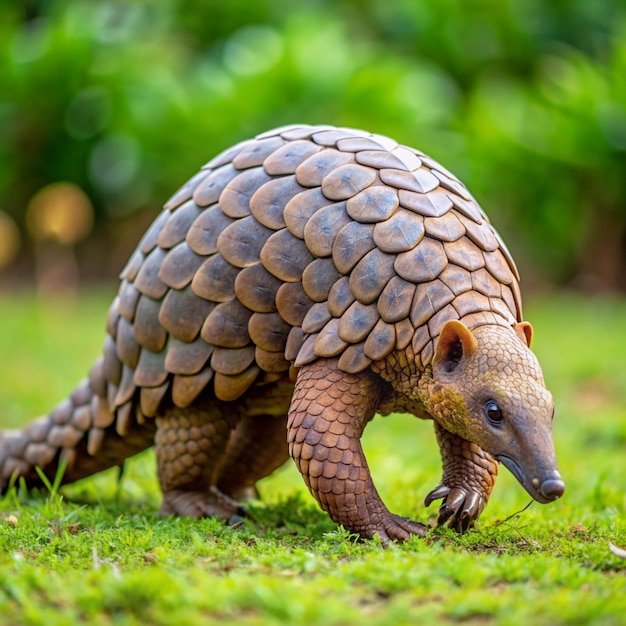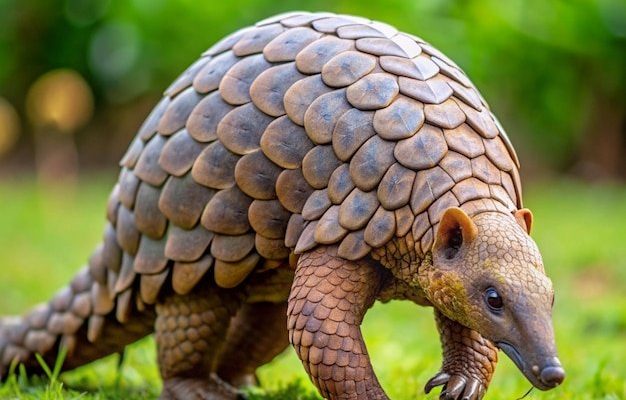
Now, you might be wondering why we should care about pangolins. Well, they play an important role in their ecosystems. They help control insect populations by eating ants and termites, which keeps nature in a healthy balance. Sadly, they are also one of the most trafficked mammals in the world due to their scales, which are wrongly believed to have medicinal properties in some cultures. Understanding this remarkable creature can help raise awareness and foster conservation efforts. So, let’s dive into some fascinating facts about the Indian pangolin!
1. Unique Physical Features
The Indian pangolin is a sight to behold, sporting a body covered in hard, protective scales made of keratin—the same material as our fingernails. These scales play an important role in the pangolin’s survival, giving it a tough exterior that protects against predators. Picture a living armadillo, covered head to toe in armor!
The pangolin’s body is long and slender, typically measuring about 30 to 39 inches in length, and can weigh between 10 to 15 pounds. They have a long snout and a sticky tongue that can extend out to capture ants and termites, which is their primary food source. Their acute sense of smell helps them locate these insects buried deep within the ground or inside trees. Honestly, it’s like they have their own secret weapon for finding snacks!
2. Nocturnal Lifestyle
If you ever catch a glimpse of an Indian pangolin, it’s likely at night. These delightful creatures are primarily nocturnal, meaning they prefer to come out and play when the sun sets. Their nighttime habits help them avoid predators and reduce competition for food. Imagine sneaking out for a midnight snack—you’d probably feel safer when the world is a little quieter, right?
When foraging, pangolins use their sharp claws to dig into anthills, termite mounds, and decaying wood, showcasing their incredible dexterity. They have a unique way of curling up into a ball when threatened, using their hard scales as a defense mechanism. It’s like carrying your own little fortress everywhere you go!
3. Habitat and Range
The Indian pangolin can be found across a variety of landscapes, from grassy plains to forested areas. They prefer regions with plenty of insects, as that’s their main source of food. You’ll mainly spot them in India, Sri Lanka, and some parts of Southeast Asia. However, their range is shrinking due to habitat loss and human encroachment.
What’s intriguing is how adaptable these creatures are; they can survive in both tropical and dry regions. It’s a reminder of how resilient nature can be but also raises the alarm on how important it is to protect their habitats. Respecting their homes is key to ensuring they continue to thrive in the wild!
4. Their Diet: Ant-astic Eaters!
Pangolins are true insectivores, honing in on ants and termites. Their diet is about 80% ants and termites, making them essential for controlling these populations. Using their long, sticky tongues, they can slurp up thousands of insects in one night. Just imagine a tongue so long that it can reach deep into the earth to pull out tasty snacks!
They don’t have teeth, so their stomachs are specially adapted to grind up the insects after swallowing them whole. This process is somewhat similar to how a bird uses grit to help digest food. Each pangolin plays a crucial role in its ecosystem, managing insect populations that could otherwise explode.
5. Reproduction and Lifecycle
The breeding habits of Indian pangolins are quite sweet. Female pangolins typically give birth to a single offspring after a gestation period of about 70 to 140 days. When born, the babies are incredibly vulnerable and rely heavily on their mothers for warmth, protection, and nourishment. These little ones are born without scales and gradually develop them over time, much like how a young turtle grows its shell.
Interestingly, pangolins are known to be solitary creatures. Once the young pangolins are weaned, they often continue to stay with their mothers for several months before venturing out on their own. It’s a loving family dynamic, even though it might seem lonely at times.
6. Threats Facing Indian Pangolins
Unfortunately, Indian pangolins are facing significant threats. They are heavily hunted for their scales, which are mistakenly thought to have medicinal properties. Despite being protected under various wildlife laws, illegal trade continues to endanger their populations. You might say they’re caught in the crossfire between traditional beliefs and conservation efforts.
Habitat loss due to deforestation is another major concern. As their homes are destroyed, they struggle to find food and shelter. This dual threat puts them at a high risk of extinction, highlighting why conservation efforts are so vital for their survival.
7. Pangolin Conservation Efforts
The good news is that there are ongoing conservation efforts aimed at protecting the Indian pangolin. Organizations work tirelessly to raise awareness about the plight of these animals, educating local communities about the importance of preserving wildlife. Some initiatives focus on law enforcement to combat poaching and illegal trade in pangolin scales.
Additionally, wildlife reserves in India promote the protection of their habitats. It’s like a team effort—local farmers, conservationists, and wildlife officials working together to create a safe space for these creatures. Every little bit helps, and it’s a reminder that protecting nature is everyone’s responsibility.
8. Cultural Significance
In some cultures, pangolins are viewed as symbols of protection due to their unique armor. People often tell stories about these creatures, emphasizing their resilience and survival skills. In traditional medicine, there are misconceptions about the benefits of pangolin scales, driving some of the illegal trade.
However, education plays a critical role here. As awareness grows, so does the understanding that pangolin scales can’t cure ailments. It’s important to shift cultural perceptions and recognize these animals for their role in the ecosystem rather than as sources for medicinal products. Helping people appreciate the real value of pangolins is crucial for their conservation.
9. The Future of the Indian Pangolin
The future of the Indian pangolin depends heavily on our actions today. If we can improve awareness and strengthen conservation efforts, there’s hope for this incredible species. It’s essential that we all play a part—whether that’s supporting conservation organizations, spreading the word, or simply appreciating wildlife in our everyday lives.
By fostering a deeper understanding and respect for them, we can help secure a future where Indian pangolins can thrive in their natural habitats, free from the threat of poaching. After all, every creature has its role in the grand scheme of life.
10. Fun Facts to Remember
Here are a few quick, fun facts to wrap things up about the Indian pangolin:
- Pangolins can consume up to 70 million insects a year—talk about a big appetite!
- They can curl up into a ball, using their scales as armor against predators.
- Pangolins are the only mammals with scales covering their bodies.
- They have a special digestive system that helps them break down tough insect exoskeletons.
The Indian pangolin, with its unique features and interesting lifestyle, truly deserves our admiration and protection.
In conclusion, the Indian pangolin is not just another animal; it’s a vital part of our ecosystem that needs our attention and support. By learning more about their lives and challenges, we can encourage others to respect and protect these amazing creatures. Remember, with knowledge comes the power to change, and protecting the pangolin may just be one small step toward a healthier planet for all.

